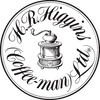Modern trends have shifted to ever lighter, more acidic and fruity coffees. Dark roasted beans are dismissed as simply burnt by some roasters. Yet, I would say that there are subtleties to be found in dark roast coffees.
If you look at the surface of something, you cannot see what qualities it contains. The surface of a coffee bean is no different. It might look fully developed on the outside, but the centre of the bean might still be raw giving a grassy taste. It might look almost black on the outside at a glance, but inside it will be only brown and will have a powerful smoky flavour.
In the late 1700s, coffee was being roasted mainly in small quantities in pans or in early hand turned drums over a fire. The beans were not graded in the same way as they are now, so would have been more varied in density and size. The roasts would therefore likely be uneven, with some quite dark and maybe burnt and others lighter. The person roasting would have only looked at the overall colour of the batch when deciding whether it was ready or not. The fire would produce a smoky flavour. The brewing of the coffee was also quite unsophisticated. The coffee served in the coffee houses was mainly boiled in a large pot or cauldron and was often ‘enhanced’ with all manner of ingredients. The slow delivery time and cost of coffee led to much tampering with the recipe in order to stretch it as much as possible.







